I need to draw the following function, which is what I call theory data

with a=z-(L/2) b=z+(L/2) for the following case
- N=75
- I=1
- L=0.16
- R=0.013
for z between -0.011 and 0.011. My guess is that there are underflow issues. The code is as follows
import numpy as np
import matplotlib.pyplot as plt
class Solenoid():
def __init__(self,N,I,L,R):
self.N=N
self.I=I
self.L=L
self.R=R
def field(self,z):
mu=4*(np.pi)*(10 ** -7)
coef=(mu*self.N*self.I)/(2*self.L)
a=z+(self.L/2)
b=z-(self.L/2)
sum_a=a/((self.R ** 2 + a ** 2) ** 0.5)
sum_b=b/((self.R ** 2 + b ** 2) ** 0.5)
return (coef*(sum_a - sum_b))
sol=Solenoid(75,1,0.160,0.013)
x=np.linspace(-0.011, 0.011, 10000)
y=[]
for point in x:
y.append(sol.field(point))
plt.plot(x,y)
plt.show()
The output is

which is plain wrong. The expected output is a more or less smooth line along with experimental data:

UPDATE New output is

